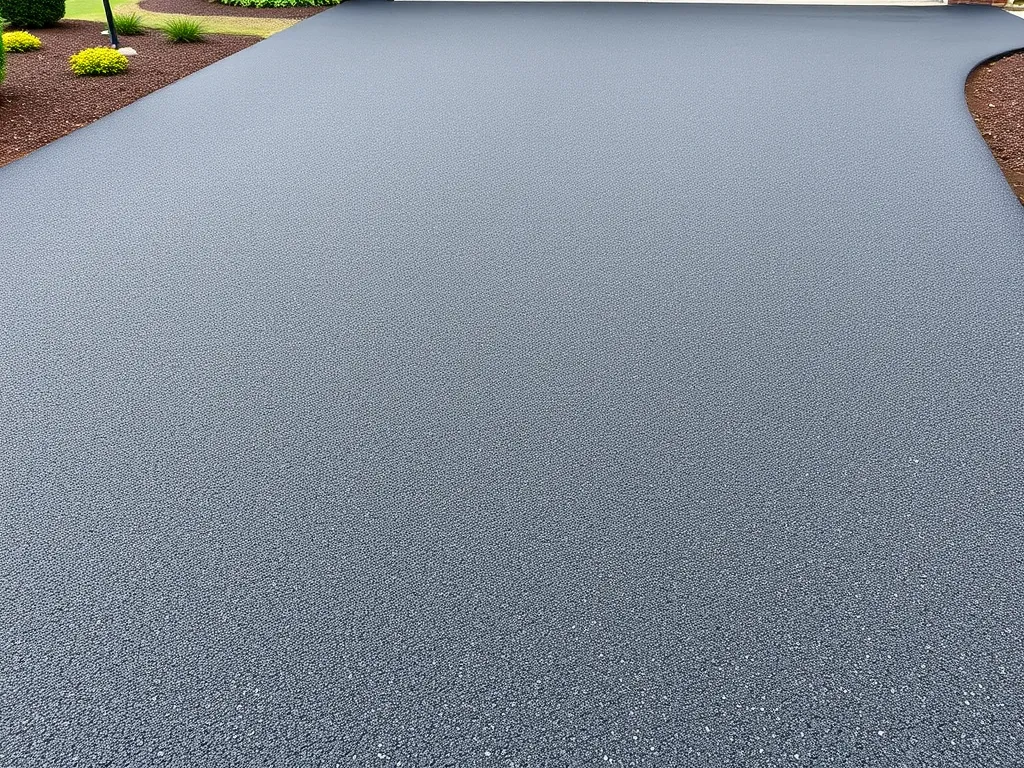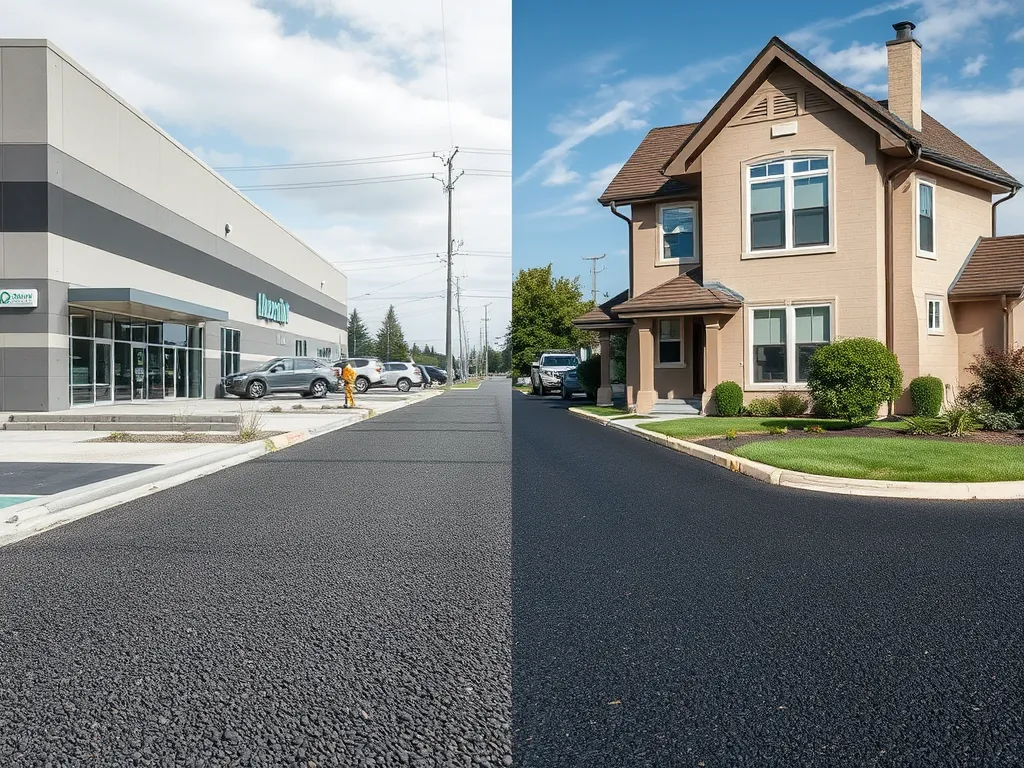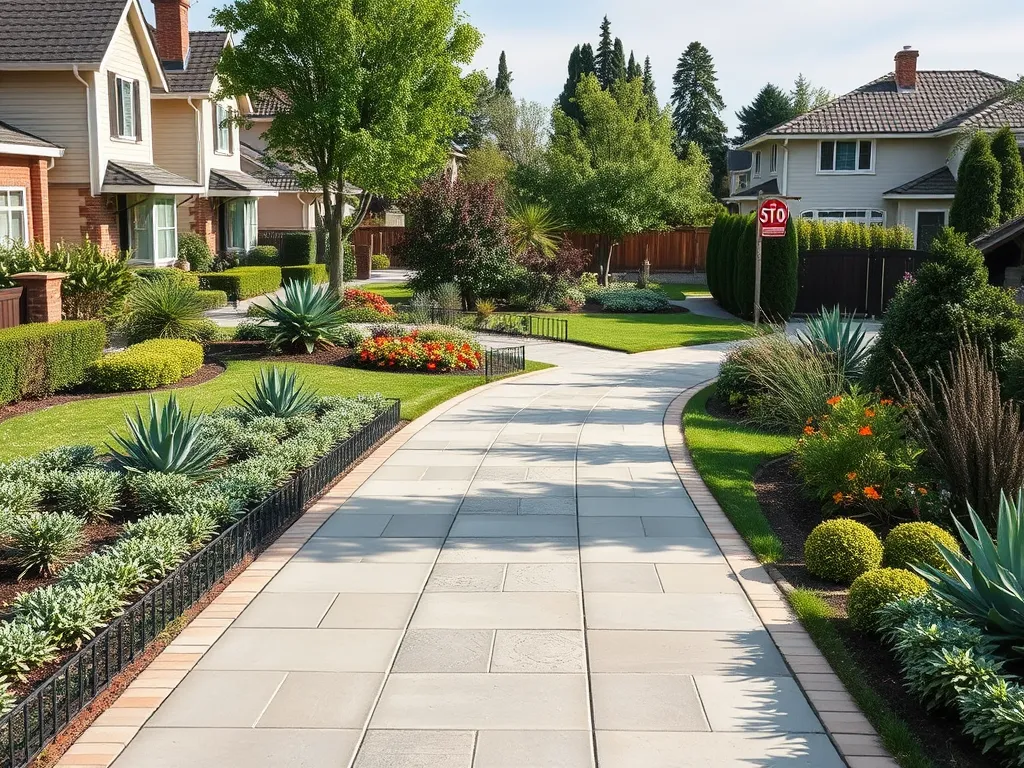Commercial Vs Residential Asphalt Maintenance: Key Differences & Practices
Published on: October 20, 2025 | Last Updated: April 14, 2025
Written By: George Voss
Commercial and residential asphalt maintenance differ in traffic demands, repair methods, and budget requirements. Commercial surfaces handle heavier vehicles and higher traffic volumes, requiring thicker asphalt layers (4-8 inches) and frequent sealcoating every 1-2 years. Residential driveways typically use 2-3 inch layers with sealcoating every 3-5 years. Both need crack filling and pothole repairs, but commercial projects often use infrared asphalt repair for faster fixes during off-hours.
This guide breaks down asphalt care by property type. You’ll learn how load capacity affects material choices, compare costs per square foot ($0.50-$1.50 residential vs $1.50-$4 commercial), and explore eco-friendly recycling options. We’ll cover parking lot striping protocols, driveway edge sealing techniques, and how freeze-thaw cycles impact repair schedules in different climates.
Contents
- Key Differences Between Commercial and Residential Asphalt
- Asphalt Maintenance for Commercial Properties
- Residential Asphalt Driveway Maintenance
- Cost Comparison: Commercial Vs Residential Asphalt Upkeep
- Maintenance Schedules for Asphalt Surfaces
- Pros and Cons Of Asphalt Maintenance Approaches
- Environmental Considerations in Asphalt Care
- FAQs: Commercial Vs Residential Asphalt Maintenance
- Closing Thoughts
- Additional Resources for You:
Key Differences Between Commercial and Residential Asphalt
Commercial and residential asphalt surfaces face distinct demands that shape maintenance strategies. Let’s break down the core factors driving upkeep decisions.
Traffic Volume and Load Capacity
Commercial asphalt handles 500-2,000+ vehicles daily, including delivery trucks with 30,000+ lb axle loads. Parking lot asphalt maintenance requires designs supporting 50-100 PSI tire pressure from semi-trailers. Residential driveways typically manage 2-5 passenger vehicles under 3,000 lbs. This gap means commercial asphalt repair needs heavy-duty patching compounds rated for 400°F+ temps, while residential fixes use standard cold-mix asphalt.
Asphalt Thickness and Structural Design
Commercial pavements use 3-5 inches of surface course over 6-8 inches of crushed stone base. Residential driveways often have 2-3 inches of asphalt on 4-6 inches of compacted gravel. Thicker commercial asphalt upkeep includes milling 1.5-2 inches during resurfacing versus 0.5-1 inch for residential paving maintenance. Infrared repairs for commercial lots restore 4-6 inch depths to match structural specs.
Material Composition Variations
Commercial mixes contain PG 64-22 performance-graded binders and 1.5-inch aggregates to resist rutting. Residential asphalt uses PG 58-28 binders with 0.75-inch stones for smoother finishes. These differences impact maintenance: commercial sealcoating requires coal-tar emulsions or polymer-modified asphalt, while residential projects often use asphalt-based sealers. Crack fillers for business asphalt maintenance contain rubberized polymers, whereas residential driveways use standard asphalt emulsion fillers.
These foundational differences directly influence maintenance approaches for parking lots versus driveways. Up next: specific techniques for preserving commercial surfaces under heavy use.
Asphalt Maintenance for Commercial Properties
Commercial asphalt surfaces face unique demands from heavy vehicles, constant traffic, and expansive layouts. Effective maintenance preserves functionality, safety, and curb appeal while minimizing liability risks. Specialized strategies address these challenges head-on.
Parking Lot Asphalt Maintenance Strategies
Parking lots require proactive care to handle daily wear. Regular inspections spot early damage, while targeted treatments prevent costly repairs.
High-Traffic Area Crack Sealing
Entrances, exits, and loading zones develop cracks faster due to repeated stress. Hot-pour rubberized sealants fill gaps up to 1 inch wide, preventing water infiltration. Proper application in temperatures above 50°F ensures adhesion. Neglected cracks can expand 300% faster in commercial zones compared to residential areas.
Commercial Sealcoating Frequency
Sealcoating shields asphalt from UV rays, chemicals, and fuel spills. Commercial lots need fresh coatings every 12-18 months—twice as often as residential driveways. Coal tar-based sealants provide superior resistance for lots handling 500+ vehicles daily. Spray systems cover 10,000 sq ft in under two hours, minimizing business disruptions.
Heavy-duty Asphalt Repairs for Businesses
Commercial repairs prioritize speed and durability. Industrial-grade materials withstand forklifts, delivery trucks, and constant turning movements.
Pothole Patching for Commercial Pavement
Infrared patching blends new and existing asphalt for seamless repairs. This method fixes potholes up to 4 sq ft in 20 minutes, with 85% strength recovery. For larger voids, full-depth excavation replaces compromised base layers. Temporary cold-mix patches work for emergency repairs during winter freeze-thaw cycles.
Resurfacing Commercial Driveways
Commercial driveways typically need resurfacing every 5-7 years. Milling removes 1.5-2 inches of degraded surface before applying fresh asphalt. Polymer-modified mixes extend service life by 40% compared to standard residential grades. Slope adjustments during resurfacing improve drainage, reducing water damage risks.
While commercial properties demand robust solutions, residential driveways require different care tactics. Next, we explore maintenance methods tailored for home asphalt surfaces.

Residential Asphalt Driveway Maintenance
Home driveways face unique wear from cars, weather, and foot traffic. Proper care stops small issues from becoming costly fixes. Focus on crack filling, sealcoating, and pothole fixes made for home use.
Driveway-specific Crack Filling Techniques
Hairline cracks under 1/4 inch need liquid crack filler. Use rubberized asphalt emulsion for gaps up to 1 inch. For wider splits or alligator cracks, cut out damaged areas and pack with hot-pour rubber. DIY kits work for small jobs, but pros handle deep base failures. Fix cracks fast to block water from eroding the base.
Residential Sealcoating Best Practices
Seal home driveways every 2-3 years. Use coal tar or asphalt-based sealant. Apply in dry, 70°F+ weather for best cure. Spray systems cover fast; squeegees give thicker coats. Keep traffic off for 24-48 hours. Proper sealcoating blocks UV rays, oil spills, and water damage.
Addressing Potholes in Home Driveways
Small holes under 6 inches can use cold patch asphalt. Compact layers with a hand tamper. Bigger voids need hot mix asphalt and plate compactors. If potholes return fast, check for base washouts. Home fixes cost $50-$200; base repairs run $1,000+. Act quick to stop cracks from spreading.
While home care focuses on spot fixes, commercial asphalt upkeep tackles larger scale wear. Costs and methods shift when moving from driveways to parking lots.
Also See: Asphalt Paving in Hot Weather: Key Tips for Success
Cost Comparison: Commercial Vs Residential Asphalt Upkeep
Maintaining asphalt surfaces demands distinct financial planning for commercial and residential properties. From material choices to labor demands, costs diverge based on scale, design, and traffic patterns.
Material and Labor Cost Factors
Commercial asphalt maintenance typically requires higher-grade materials. PG 64-22 binders (engineered for heavy loads) and 4-6 inch base layers are standard for parking lots. Residential driveways often use PG 58-28 binders with 2-3 inch bases. These differences create a 30-50% material cost gap per square foot.
Labor costs amplify commercial expenses. Projects like parking lot asphalt maintenance need milling machines, infrared patching systems, and crews of 5-8 workers. Residential jobs average 2-3 workers with compact rollers. Commercial labor rates range $45-$75/hour versus residential’s $30-$50/hour.
Long-term Maintenance Budgeting
Commercial properties face recurring costs from frequent wear. A 100,000 sq ft parking lot may spend $1.50-$3.00/sq ft annually on upkeep asphalt commercial tasks like crack sealing and pothole patching. Residential driveways average $0.50-$1.50/sq ft yearly, focusing on sealcoating every 3-5 years.
Lifecycle planning differs sharply. Businesses budget for full-depth repairs ($4-$8/sq ft) every 8-12 years. Homeowners prioritize preventive measures: 95% opt for crack filling within 2 years of installation. Commercial asphalt repair maintenance often includes annual infrared patches at $120-$180 per pothole.
While cost factors shape initial budgets, maintenance frequency determines ongoing expenses. Next, we’ll break down optimal schedules for both property types.

Maintenance Schedules for Asphalt Surfaces
Road care plans shift based on use. Work for shops needs more checks than home drives. Both need timed care to last.
Commercial Asphalt Upkeep Frequency
Store lots face trucks, cars, and foot flow daily. Check cracks every 3 months. Seal coat each 1-2 years. Fix holes in 3 days. Use tough mixes like PG 64-22 binders. These handle hot and cold swings. Fast fixes stop small flaws from growing. Plan for 5-7% of lot cost each year for upkeep.
Residential Driveway Maintenance Timeline
Home drives see less strain. Check for cracks twice a year. Seal coat every 3-4 years. Fill gaps within 14 days. Patch holes in 7 days. Use thin-film seals for cost cuts. Skip steel rollers – walk-behind gear works. Budget $0.10-$0.25 per sq.ft. yearly.
Set plans keep roads smooth. But which care steps give more bang for your buck? We break down the pros and cons next.
Pros and Cons Of Asphalt Maintenance Approaches
Balancing durability needs with budget realities shapes asphalt care strategies. Commercial and residential properties demand distinct methods, each carrying specific trade-offs.
Commercial Asphalt Upkeep Advantages/challenges
Parking lot asphalt maintenance prioritizes heavy-load endurance. PG 76-22 binders (high-temperature asphalt cement) and stone matrix mixes handle semi-truck weights up to 40,000 lbs. Benefits include:
- Extended surface life (15-20 years with proper care)
- Nightly crack sealing during low-traffic hours
- Tax-deductible repairs under Section 179
Challenges surface in business asphalt maintenance:
- $3-$7 per sqft for pothole patching vs $1-$3 residential
- Mandatory ADA-compliant repairs within 72 hours of damage reports
- Frequent sealcoating every 12-18 months
Residential Driveway Maintenance Benefits/limitations
Home asphalt upkeep focuses on curb appeal and moderate use. Most driveways use PG 64-22 binders rated for passenger vehicles. Key perks:
- DIY-friendly sealcoating kits ($0.15-$0.25 per sqft)
- 5-7 year resurfacing cycles
- Smaller repair zones (under 10 sqft typically)
Limitations involve:
- Oil stains degrading binder integrity within 6 months
- Freeze-thaw cracks expanding 0.25″ yearly without treatment
- No tax incentives for private pavement care
These maintenance realities set the stage for evaluating environmental impacts. Property managers and homeowners alike face choices affecting local ecosystems.

Environmental Considerations in Asphalt Care
Property owners face unique environmental challenges when maintaining asphalt surfaces. Commercial and residential projects require distinct approaches to balance durability with ecological responsibility.
Eco-friendly Sealcoating Options
Sealcoat formulations differ sharply between parking lots and driveways. Commercial asphalt maintenance often uses low-VOC (volatile organic compound) sealants meeting EPA standards of <450g/L. These water-based products reduce air pollution while handling heavy truck traffic. Residential asphalt upkeep favors plant-based sealers with soybean or pine tar derivatives - gentler for homes but less durable than commercial-grade options.
| Property Type | Sealcoat Type | Drying Time | Cost/Sq Ft |
|---|---|---|---|
| Commercial | High-solids emulsion | 8-12 hrs | $0.18-$0.35 |
| Residential | Bio-based acrylic | 24-36 hrs | $0.12-$0.22 |
Recycling Asphalt Materials
The asphalt industry recycles 95% of removed pavement, but methods vary by property scale. Commercial asphalt repair maintenance typically uses cold planing – grinding surface layers into RAP (reclaimed asphalt pavement) for reuse onsite. Residential projects often mix millings with fresh binder for driveway repairs, saving 30-40% versus new materials.
Key recycling differences emerge in material volumes: Commercial: 50-100 tons per acre recycled through full-depth reclamation Residential: 2-5 tons reused through small-batch processing
Proper asphalt care reduces environmental strain across property types. Upkeep choices directly impact local ecosystems and long-term pavement performance. Next, we examine how maintenance schedules differ between commercial and residential needs.
FAQs: Commercial Vs Residential Asphalt Maintenance
What’s the Difference in Asphalt Quality Between Commercial and Residential?
Commercial asphalt is designed to withstand heavier traffic and loads, typically utilizing higher-grade materials, including performance-graded binders and thicker layers, while residential asphalt is formulated for lighter vehicle loads, often using standard materials suitable for typical home use.
How Often Should Residential Driveways Be Sealcoated?
Residential driveways should be sealcoated every 3 to 5 years to maintain their durability and appearance. Factors such as climate and usage can influence the exact timing, so routine inspections are recommended.
What Routine Maintenance Extends Asphalt Pavement Life?
Routine maintenance that significantly extends asphalt pavement life includes regular crack sealing, timely pothole repairs, and periodic sealcoating. Ensuring prompt attention to these areas can prevent more severe damage and costly repairs down the line.
Does Commercial Asphalt Require More Frequent Repairs?
Yes, commercial asphalt typically undergoes more frequent repairs due to higher traffic volumes and heavier loads. Commercial surfaces often require maintenance every 1 to 2 years, whereas residential asphalt maintenance tends to occur every 3 to 5 years.
Closing Thoughts
Understanding the differences in asphalt maintenance for commercial and residential properties is crucial. The varying traffic volumes, load capacities, and maintenance requirements dictate different strategies. Businesses may face the challenges of high traffic and heavy-duty repairs, while homeowners often focus on aesthetic longevity and surface integrity.
When choosing maintenance methods, consider factors such as frequency, material costs, and environmental implications. Emphasizing upkeep not only prolongs asphalt life but also enhances property value. Tailoring maintenance approaches based on your specific needs ensures effective and cost-efficient care.
For more information on asphalt maintenance and calculators to help with your projects, visit Asphalt Calculator USA.


